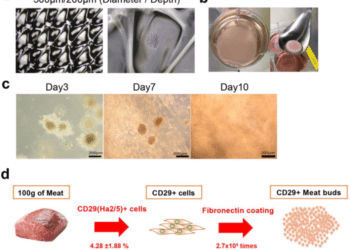
The prospect of cultured meat is enticing for several reasons. For starters, it’s more ethical — you don’t need to kill billions of animals every year. It could also be better for the environment, producing lower emissions and requiring less land and water than “traditional” meat production, and would also reduce the risk of new outbreaks (potentially pandemics) emerging. To top it all off, you can also customize cultured meat with relative ease, creating products that perfectly fit consumers’ tastes.
But there are also big challenges. In addition to the technological challenges, there is the need to ensure meat culturing is not only feasible and scalable but also cheap. There’s also a more pragmatic problem: taste. There’s a lot to be said about why people enjoy eating meat, but much of it boils down to how good it tastes. Meanwhile, cultured meat has an undeniable “artificial” feel to it (at least for now). Despite being made from the exact same cells as “regular” meat, it seems unnatural and unfamiliar, so there are fears that consumers may reject it as unappealing.
Before you even try it
A recent study underlines just how big this taste challenge is — and how perception (in addition to the taste per se) could dissuade people from consuming cultured meat. According to the research, which gathered data from 1,587 volunteers, 35% of non-vegetarians and 55% of vegetarians find cultured meat too disgusting to eat.
“As a novel food that humans have never encountered before, cultured meat may evoke hesitation for seeming so unnatural and unfamiliar—and potentially so disgusting,” the researchers write in the study.
For vegetarians, the aversion towards cultured meat makes a lot of sense. For starters, even though it’s not meat from a slaughtered animal, it’s still meat, and therefore has a potential to elicit disgust.
“Animal-derived products may be common triggers of disgust because they traditionally carry higher risks of disease-causing microorganisms. Reminders of a food’s animal origin may evoke disgust particularly strongly among vegetarians,” the study continues.
For non-vegetarians, it’s quite the opposite: it can elicit disgust because it’s not natural enough. Many studies highlight that meat-eaters express resistance to trying cultured meat because of its perceived unnaturalness. So if you’d want to make cultured meat more appealing for consumers, you’d have to approach things differently for vegetarians and non-vegetarians. For instance, perceiving cultured meat as resembling animal flesh predicted less disgust among meat-eaters but more disgust among vegetarians. But there were also similarities between the two groups. Perceiving cultured meat as unnatural was strongly associated with disgust toward it among both vegetarians and meat-eaters. Combating beliefs about unnaturalness could go a long way towards convincing people to at least give cultured meat a shot.

Even before people eat a single bite of cultured meat, their opinion may already be shaped. If we want to get people to consume this type of product, tackling predetermined disgust is a big first step. Different cultures could also have widely different preferences in this regard.
“Cultured meat offers promising environmental benefits over conventional meat, yet these potential benefits will go unrealized if consumers are too disgusted by cultured meat to eat it.”
Okay, but is cultured meat actually good?
Full disclosure: no one at ZME Science has tried cultured meat yet (but we’re working on it). Even if we had, our experience wouldn’t be necessarily representative of the greater public. Herein lies one problem: compared to how big the potential market is, only a handful of people have actually tasted this type of meat. We don’t yet have large-scale surveys or focus groups (or if companies have this type of data, they haven’t publicly released it from what we could find).
The expert reviews seem to be somewhat favorable. In a recent blind test, Israel Master Chef judge Michal Ansky was unable to differentiate between “real” chicken and its cultured alternative. Ansky tasted the cultured chicken that was already approved for consumption in Singapore (the first place where cultured meat has been approved).
The remarkable progress that cultured meat has made in regards to its taste was also highlighted by a recent study from The Netherlands, in which blind-tested participants preferred the taste of cultured meat.
“All participants tasted the ‘cultured’ hamburger and evaluated its taste to be better than the conventional one in spite of the absence of an objective difference,” the researchers write.
The study authors also seemed confident that cultured meat could become mainstream given its appealing taste and environmental advantages.
“This study confirms that cultured meat is acceptable to consumers if sufficient information is provided and the benefits are clear. This has also led to increased acceptance in recent years. The study also shows that consumers will eat cultured meat if they are served it,” said Professor Mark Post from Maastricht University, one of the study authors.
Researchers are also close to culturing expensive, gourmet types of meat, including the famous Wagyu beef, which normally sells for around $400 for a kilogram. Researchers are already capable of culturing bits of this meat four times cheaper, and the price is expected to continue going down. This would be a good place for cultured meat to start, making expensive types of meat more available to the masses.
Still, there are some differences between most types of cultured meat and meat coming from animals. For instance, one study that used an “electronic tongue” to analyze the chemical make-up of the meat found “significant” differences.
“There were significant differences in the taste characteristics assessed by an electronic tongue system, and the umami, bitterness, and sourness values of cultured muscle tissue were significantly lower than those of both chicken and cattle traditional meat,” the study reads. But the same study also suggests that understanding these differences could make cultured meat even more realistic and palatable.
This technology is also progressing very quickly in this regard, and every year, cultured meat seems to be taking strides towards becoming more affordable and tasty. There are multiple companies pending approval to embark on mass production, using somewhat different technologies and products. There are multiple types of meat on the horizon, from chicken and beef to pork and even seafood, and for many of them, the taste data is only just coming in.
All in all, cultured meat promises to be one of the biggest food revolutions in the past decades. Whether it will actually deliver on this promise is a different problem that will hinge on several variables, including price, taste, and of course, environmental impact. If companies can deliver a product that truly tastes like traditional meat, they have a good chance. There’s still a long road before the technology becomes mainstream, but given how quickly things have progressed thus far, we may see cultured meat on the shelves sooner than we expect.






